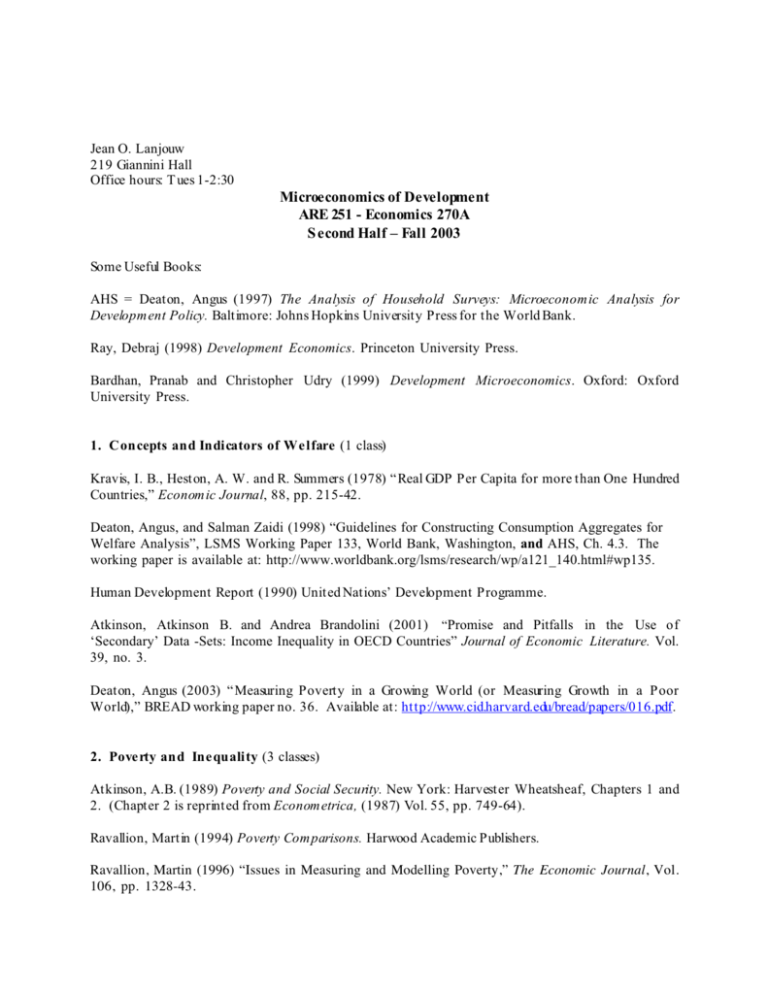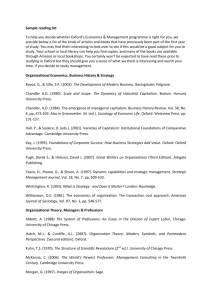Microeconomics of Development ARE 251
advertisement

Jean O. Lanjouw 219 Giannini Hall Office hours: T ues 1-2:30 Microeconomics of Development ARE 251 - Economics 270A S econd Half – Fall 2003 Some Useful Books: AHS = Deaton, Angus (1997) The Analysis of Household Surveys: Microeconomic Analysis for Development Policy. Baltimore: Johns Hopkins University Press for the World Bank. Ray, Debraj (1998) Development Economics. Princeton University Press. Bardhan, Pranab and Christopher Udry (1999) Development Microeconomics. Oxford: Oxford University Press. 1. Concepts and Indicators of We lfare (1 class) Kravis, I. B., Heston, A. W. and R. Summers (1978) “ Real GDP Per Capita for more than One Hundred Countries,” Economic Journal, 88, pp. 215-42. Deaton, Angus, and Salman Zaidi (1998) “Guidelines for Constructing Consumption Aggregates for Welfare Analysis”, LSMS Working Paper 133, World Bank, Washington, and AHS, Ch. 4.3. The working paper is available at: http://www.worldbank.org/lsms/research/wp/a121_140.html#wp135. Human Development Report (1990) United Nations’ Development Programme. Atkinson, Atkinson B. and Andrea Brandolini (2001) “Promise and Pitfalls in the Use of ‘Secondary’ Data -Sets: Income Inequality in OECD Countries” Journal of Economic Literature. Vol. 39, no. 3. Deaton, Angus (2003) “ Measuring Poverty in a Growing World (or Measuring Growth in a Poor World),” BREAD working paper no. 36. Available at: http://www.cid.harvard.edu/bread/papers/016.pdf. 2. Pove rty and Ine quality (3 classes) Atkinson, A.B. (1989) Poverty and Social Security. New York: Harvester Wheatsheaf, Chapters 1 and 2. (Chapter 2 is reprinted from Econometrica, (1987) Vol. 55, pp. 749-64). Ravallion, Martin (1994) Poverty Comparisons. Harwood Academic Publishers. Ravallion, Martin (1996) “Issues in Measuring and Modelling Poverty,” The Economic Journal, Vol. 106, pp. 1328-43. Lanjouw, Peter and Nicholas Stern (1991) “ Poverty in Palanpur,” World Bank Economic Review. Vol. 5, no. pp. 23-55. And in Lanjouw, P.F., and Stern, N.H. (eds) (1998): Economic Development in Palanpur Over Five Decades (Oxford: Oxford University Press). Howes, Stephen and J. O. Lanjouw (1998) “Does Sample Design Matter for Poverty Comparisons?” Review of Income and Wealth. Series 44, no. 1. pp. 99-109. Sen, Amartya with James Foster (1998) On Economic Inequality. Oxford: Oxford University Press. Haddad, Lawrence and Ravi Kanbur (1990) “ How Serious is the Neglect of Intra-Household Inequality?” The Economic Journal. Vol. 100. pp. 866-881. Atkinson, A.B. and F. Bourgignon (1987) “ Income Distribution and Differences in Needs,” in George R. Feiwel (ed.) Arrow and the Foundations of the Theory of Economic Policy (London: Macmillan Press). 3. Disaggre gate d Estimation and Targe ting (2 classes) Elbers, Chris, J.O. Lanjouw and Peter Lanjouw. (2003) “Micro-Level Estimation of Poverty and Inequality,” Econometrica. Vol. 71, no. 1, pp. 355-64. McKenzie, David J. (2003) “Measuring Inequality with Asset Indicators,” BREAD Working Paper no. 042. Available: at http://www.cid.harvard.edu/bread/042.htm. Coate, Steven and Timothy Besley (1992) “Workfare vs. Welfare Incentive Arguments for Work Requirements in Poverty-Alleviation Programs,” American Economic Review. Vol. 82, no. 1, pp. 249-61. Datt, G. and M. Ravaillon (1994) “ T ransfer Benefits from Public-works Employment: Evidence for Rural India,” The Economic Journal. Vol 104, no. 427, pp. 1346-1369. Jacoby, Hanan (1997) “Self-selection and the redistributive impact of in-kind transfers – an econometric approach,” Journal of Human Resources. Vol. 32, no. 2, pp. 233-49. 4. Intra-Household Allocations (2 classes) Chen, M. and J. Dreze (1992) “ Widows and Well-Being in Rural North India,” Development Economics Research Programme Working Paper no. 40. STICERD. London School of Economics. Sen, Amartya (1990) “ More T han 100 Million Women are Missing,” New York Review of Books. (December 20, 1990) pp. 61-66. Deaton, Angus (1989) “ Looking for Boy-Girl Discrimination in Household Expenditure Data,” World Bank Economic Review. Vol. 3, no. 1, pp. 1-15. and AHS, ch. 4.2. T homas, Duncan (1990) “ Intra-Household Resource Allocation: An Inferential Approach,” Journal of Human Resources, Vol. 25, pp. 635-664. Pitt, M., Rosenzweig, M. and M. D. Hassan (1990) “ Productivity, Health and Inequality in the Intrahousehold Distribution of Food in Low-Income Countries,” American Economic Review. December, pp. 1139-56. Lundberg, Shelly and Robert A. Pollak (1996) “ Bargaining and Distribution in Marriage,” Journal of Economic Perspectives. Vol. 10, no. 4, pp. 193-58. Bergstrom, T heodore C. (1996) “ Economics in a Family Way,” Journal of Economic Literature, Vol. 34, no. 4, pp. 1903-34. Lundberg, Shelly, Robert A. Pollak, and Terence J. Wales (1997) “Do Husbands and Wives Pool their Resources?” Journal of Human Resources, Vol. XXXII, no. 3, pp. 462-80. Udry, Christopher (1996) “Gender, Agricultural Production, and the Theory of the Household,” Journal of Political Economy, Vol. 104 (5), pp. 1010-1045. Duflo, Esther and Christopher Udry (2003) “ Intrahousehold Resource Allocation in Côte d’Ivoire: Social Norms, Separate Accounts and Consumption Choices,” BREAD working paper no. 016. Available at: http://www.cid.harvard.edu/bread/papers/016.pdf 5. Agricultural Land/Labor Contracts (2 classes) Eswaran, M. and A. Kotwal (1985) “ A T heory of Contractual Structure in Agriculture,” American Economic Review. Vol. 75, no. 3, pp. 352-67. Shaban, R. (1987) “ T esting Between Competing Models of Sharecropping,” Journal of Political Economy. Vol. 95, no. 5. pp 893-920. Lanjouw, J. O. (1999) “Information and the Operation of Markets: Tests Based on a General Equilibrium Model of Land Leasing in India,” The Journal of Development Economics. Vol. 60, no. 2, pp. 497-528. Banerjee, Abhijit, Paul Gertler and Maitresh Ghatak (2002) “Empowerment and Efficiency: Tenancy Reform in West Bengal,” Journal of Political Economy. Vol. 110, no. 2, pp 239-280. 6. Property Rights in Land (2 classes) De Soto, Hernando (1989) The Other Path: The Invisible Revolution in the Third World. (New York: Harper and Row, Publishers.) More recently:(2000) The Mystery of Capital. (London: Bantam Press/Random House). Friedman, J., Jimenez, E. and Mayo, S. (1988). ‘The demand for tenure security in developing countries.’ The Journal of Development Economics, vol. 29, no. 2, pp. 185-98 Feder, Gershon (1987) “Land Ownership Security and Farm Productivity,” Journal of Development Studies, pp. 16-30. Besley, Timothy (1995). ‘Property rights and investment incentives: theory and evidence from Ghana.’ Journal of Political Economy, vol. 103, no. 5, pp. 903-37. Jacoby, Hanan, Li, Guo, and Scott Rozelle (2002) “Hazards of Expropriation: Tenure Insecur ity and Investment in Rural China,” American Economic Review, vol. 92, no. 5, pp. 1420-47. Carter, Michael and Pedro Olinto (2003) Getting Institutions “Right” for Whom? Credit Constraints and the Impact of Property Rights on the Quantity and Composition of Investment,” American Journal of Agricultural Economics. Vol. 85, no. 1, pp. 173-86. Fields, Erica (2002) “Entitled to Work: Urban Property Rights and Labor Supply in Peru,” memo. Princeton University. Lanjouw, J. O. and Philip Levy (2002) “Untitled: A Study of Formal and Informal Property Rights in Urban Ecuador,” The Economic Journal. Vol. 112, pp. 986-1019. 7. Economics in the De sign of De ve lopme nt Policy: A Case Study of LDC Acce ss to Pharmace uticals (1 class) Kremer, Michael (2000) “Creating Markets for New Vaccines Part I: Rationale and Part II: Design Issues.” In Adam B. Jaffe, Josh Lerner, and Scott Stern (eds.) Innovation Policy and the Economy, Vol. 1. pp. 35-119. Available at: http://post.economics.harvard.edu/faculty/kremer/vaccine.html. TRIPS and Pharmaceutical Patents. WTO Fact Sheet. April 2001. Available at: http://www.wto.org/english/tratop_e/trips_e/factsheet_pharm00_e.htm. Drug Patents Under the Spotlight: Sharing Practical Knowledge about Pharmaceutical Patents. Médecins Sans Frontieres, Paris. Available at: http://www.acessmed-msf.org under “publications”. Lanjouw (1997) “The Introduction of Product Patents in India: ‘Heartless Exploitation of the Poor and Suffering’?” NBER Working Paper no. 6366. Integrating Intellectual Property Rights and Development Policy. Report of the Commission on Intellectual Property Rights, United Kingdom. Ch. 2: “Health.” Available at http://www.iprcommission.org. Lanjouw, J. O. (2003) “Intellectual Property and the Availability of Pharmaceuticals in Poor Countries,” Adam B. Jaffe, Josh Lerner, and Scott Stern (eds.) Innovation Policy and the Economy. Vol. 3, pp. 91-130. (MIT Press: Cambridge, MA). Available at: http://www.cgdev.org/fellows/lanjouw.html, as working paper no. 5. Lanjouw, J.O. (2003) “A Proposed Solution to the TRIPS Debate over Pharmaceuticals,” Technological Innovation and Intellectual Property Newsletter. Issue 2003.3. Available at http://www.researchoninnovation.org/tiip/index.htm. 8. Technology Adoption (1 class) Foster, Andrew and Mark Rosenzweig (1995) “Learning by Doing and Learning from Others: Human Capital and Technical Change in Agriculture,” Journal of Political Economy, Vol. 103, no. 6, pp. 1176-1209. Conley, Timothy and Christopher R. Udry (2003) “Learning about a New Technology: Pineapple in Ghana,” Mimeo. July 2003. Available at: http://www.econ.yale.edu/~cru2//pdf/conleyudry.pdf






